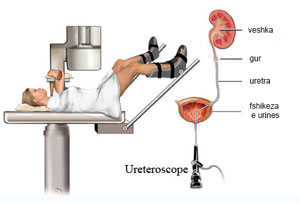Urological Procedures (Part One)
Ultrasound of the urinary system

The ultrasound is a simple, painless examination with no side effects. In the case of the urinary system, it assesses the condition of the kidneys, urinary bladder, prostate, and testicles. The patient is required to have drunk a sufficient amount of water before the examination so that the bladder is full. The procedure is performed by placing and moving a probe on the skin, over the area of the organ to be examined.
Kidney ultrasound
A normal kidney has a specific shape and size. With ultrasound, its dimensions are measured and various diseases can be discovered, such as:
- tumoral mass or cysts;
- simple stones or stones that have caused kidney enlargement, which varies from a mild degree to a severe one called hydronephrosis;
- kidney deformation as a result of infection;
- congenital kidney diseases like polycystic kidney, pelvis dilatation, absence of one kidney (agenesis), etc.
Bladder ultrasound
This examination, performed through the abdomen (transabdominal), reveals anomalies or pathologies of the urinary bladder. It is necessary for the bladder to be well filled with urine. With the help of ultrasound, the amount of urine can be measured. It is done at the beginning of the examination when the bladder is full of urine and is repeated at the end after the patient has urinated. Normally, the bladder empties completely. If immediately after urination there remains a quantity of urine in the bladder, this is called residual urine and may indicate an acute or chronic blockage of the bladder, at the same time different pathologies are discovered such as:
- tumors (cancer, papilloma);
- stones;
- inflammations such as cystitis,
- congenital anomalies like ureterocele etc..
At the same time, during this procedure, the prostate is also evaluated:
- the dimensions and volume of the prostate gland, its enlargement are determined
- calcifications or stones in it that suggest a chronic inflammation,
- hypoechoic images that direct towards prostate cancer.
- Cysts and abscesses in it, etc.
Transrectal ultrasound of the prostate
Transrectal ultrasound is an examination performed in outpatient conditions and lasts from 5 to 15 minutes which uses sound waves to create an image of the prostate gland that is transmitted to a computer. A small lubricated probe is inserted into the rectum that touches the prostate emitting waves. This procedure is mainly painless. Images of a normal prostate are different from those of its diseases.
With the help of Transrectal Ultrasound, the volume of the prostate is determined more accurately than with Transabdominal Ultrasound (from the abdomen).It is used to diagnose:
- prostate cancer in patients with elevated PSA or when there are doubts after a prostate examination with a finger through the rectum.
- inflammatory diseases of the prostate such as acute or chronic prostatitis, abscesses, stones, etc.
- and also assists in finding the cause of infertility by checking the seminal vesicles.
The most important use of it is in the accurate localization of the area where the prostate biopsy will be taken.
Ultrasound of the seminal vesicles is performed with the same probe and in the same manner as for the prostate. It is mainly used in the case of infertility and their involvement in prostate tumors.
Preparation for the examination.
To get a clearer image, the patient needs to clear the bowel from feces and gases using a micro enema the night before.
Technique
The patient lies on the left side with knees pulled up to the stomach, which is a relaxing position and makes it easier to insert the probe into the rectum.
Images
The probe sends sound waves which, according to the tissues of the prostate that penetrate, produce different images which we divide into three groups:
- Isoechoic, which represent normal tissue; in this case, the amount of waves received is the same as those sent
- Hypoechoic; the returned waves are much fewer than those sent and are often found in prostate cancer.
- Hyperechoic; the returned waves are much more than those received and indicate the presence of prostatic calcifications or small stones in the prostate.
Ultrasound of the testicles
This is performed using a special probe; the testicles and epididymis as well as the content of the scrotum are examined.
It may discover hydrocele (water accumulation), hematoma (blood accumulation) after traumas, testicular torsion, etc.. Testicular cancer or other tumors, inflammations such as orchitis, epididymitis, abscesses; cysts of the epididymis, etc. can be detected.
Hello Doctor, my daughter was born two months premature due to problems with her kidneys involving the tubes that connect to the bladder, Ureterocele. They performed a minor surgery to expand the holes in the tubes, but we were told that they have started to narrow again and she will need another procedure. Her test results were bad, initially 3, now they are 1.2, which means they have improved. She has gained weight and is drinking well at the moment. She has a catheter from the abdomen directly to the bladder to relieve her kidneys. We don't know what to do. Can you tell us how to solve this problem, if her kidneys have been damaged, and if the kidneys on the right side are functioning? She has two kidneys
Sent by Albert Syla, më 09 October 2017 në 10:21
Hello Mr. Syla,
I am sorry, but I cannot help you. I am a urologist for adults and your case needs to be consulted only with a pediatric urologist.
All the best
Replay from Dr. Shk. Rezar Rusi, më 10 October 2017 në 06:39